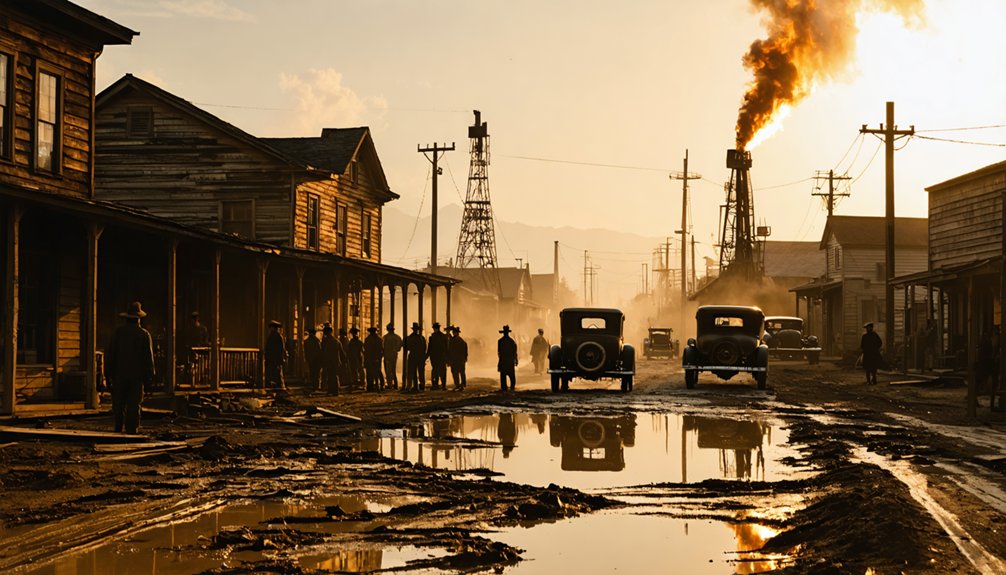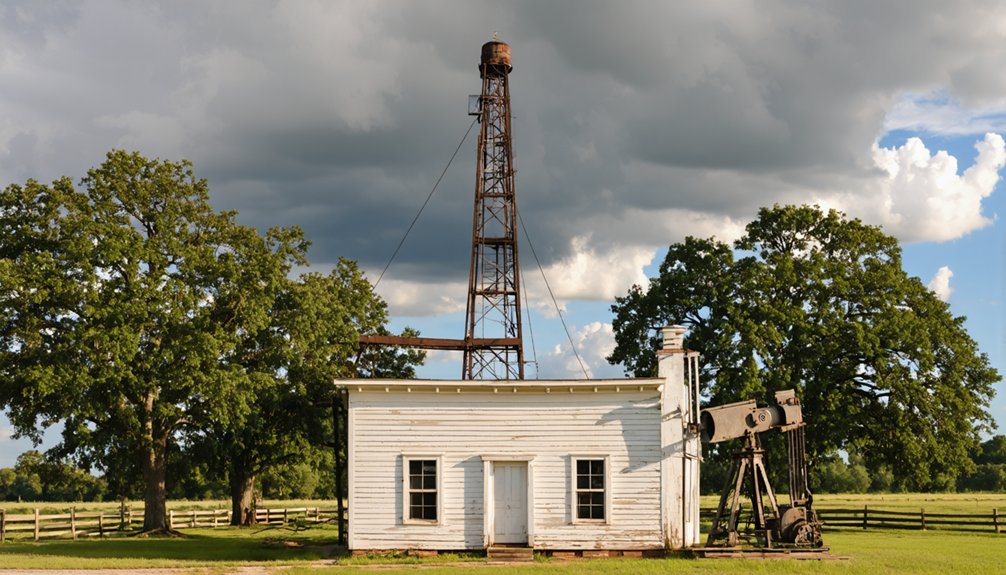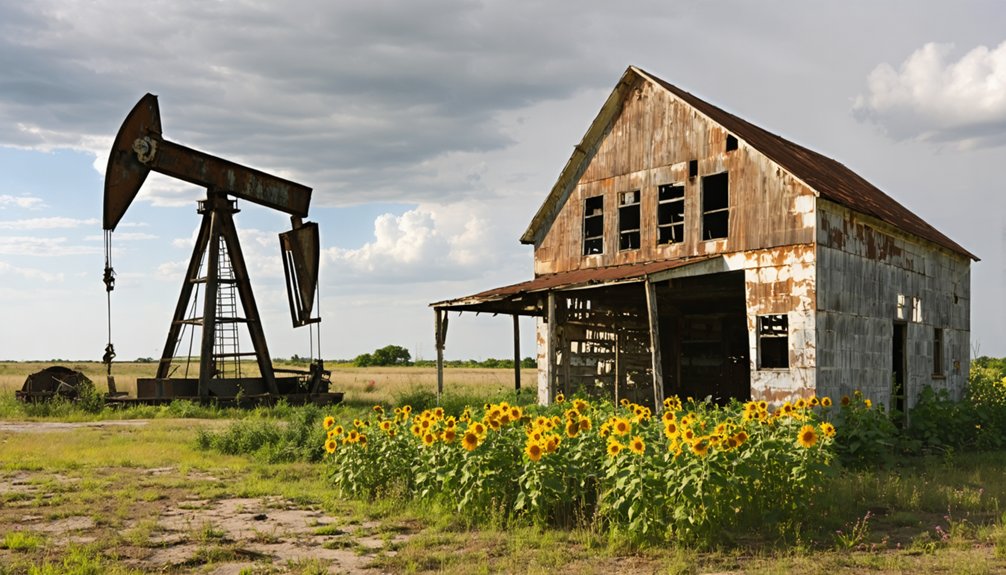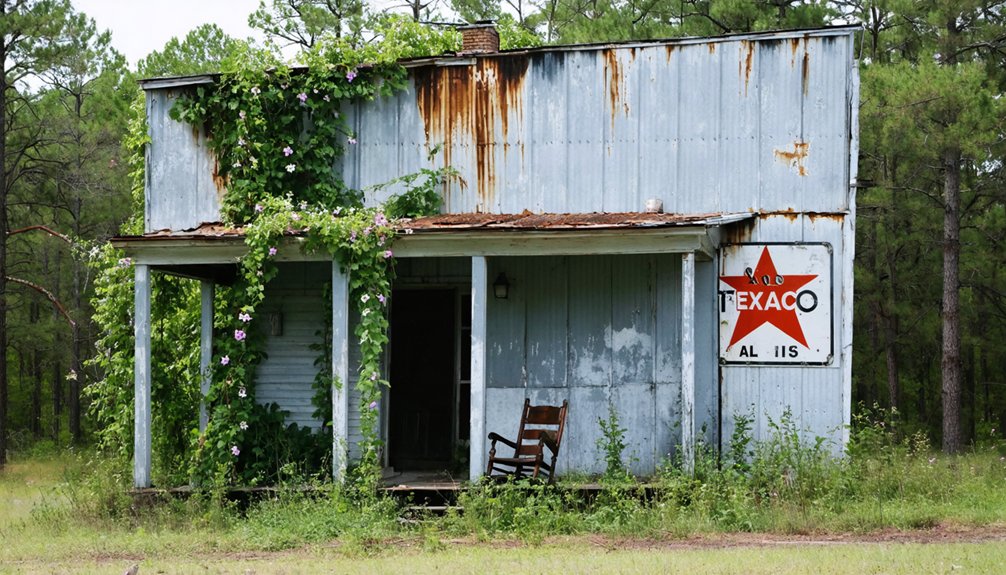You’ll find Joinerville about 7 miles west of Henderson, Texas, where a small farming settlement once stood. The community transformed in 1930 after Columbus “Dad” Joiner struck oil at the Daisy Bradford No. 3 well, producing 6,000 barrels daily. The population exploded to 1,500 residents with 35 businesses by 1931, but the boom eventually faded. Today, the Gaston Museum preserves artifacts from this remarkable chapter in Texas oil history, offering glimpses into a transformative era.
Key Takeaways
- Joinerville transformed from a bustling oil boomtown of 1,500 residents in 1931 to a much smaller community after the oil boom ended.
- The town’s rapid growth and subsequent decline followed the discovery of the Daisy Bradford No. 3 oil well in 1930.
- While no longer a thriving boomtown, Joinerville’s history is preserved through the Gaston Museum, featuring 1930s oil boom artifacts.
- The community’s transition from agricultural settlement to oil boomtown and eventual decline exemplifies the typical Texas ghost town pattern.
- Original structures and businesses that once numbered 35 establishments have largely disappeared, though the area remains historically significant.
The Birth of a Small Texas Community
Three different names marked the early identity of what would become Joinerville, Texas. You’d first know this rural settlement as Miller or Miller Schoolhouse, a sparsely populated farming area about 7 miles west of Henderson.
The community’s earliest roots trace back to when John Cherry Miller donated 1,000 acres for the Juan Ximenes Survey. The community then became Cyril before its final transformation in 1930. That’s when Columbus Marion “Dad” Joiner’s relentless oil exploration paid off, leading to the town being renamed in his honor. The influential landowner Daisy Bradford provided crucial support by leasing him 975.5 acres of her property.
Before striking oil, Joiner had moved to Texas in 1926 at age 66, defying skeptical geologists by leasing thousands of acres for drilling. His vision sparked hope among local landowners, promising community growth through new schools, parks, and museums.
These dreams would soon become reality when the Daisy Bradford No. 3 well erupted, forever changing this quiet farming community.
From Miller School to Joinerville: A Name’s Evolution
The educational roots of Joinerville began with the Miller School, established in 1916 on the Miller family farm within the old Day Ranch property.
Joinerville’s first step toward education came in 1916 when the Miller School opened its doors on the Miller family farmland.
This single-school system soon partnered with neighboring Mount Hope School, leading to their 1925 consolidation on land donated by teacher Irene Gaston. You’ll find that the new institution was aptly named Gaston School in honor of Irene and her husband Hugh. The school operated as District #68 before joining with other institutions.
As community education flourished, the town’s identity evolved. Known first as Cyril, then Miller – reflecting the Miller Family’s influence – the community underwent its final transformation around 1930.
Following Columbus Marion “Dad” Joiner’s momentous oil discovery nearby, residents renamed their town Joinerville, marking its shift from an agricultural settlement to a bustling oil boomtown. The school grew into a remarkable institution, earning recognition as the Largest Rural School in the World by the early 1930s.
Dad Joiner’s Remarkable Oil Discovery
Despite geologists’ skepticism about oil deposits in Rusk County, Columbus Marion “Dad” Joiner began his ambitious drilling venture in East Texas during 1927.
Using rusty equipment and funds from mail-order investors, he leased land from Daisy Bradford and drilled two unsuccessful wells. Undeterred by mounting debts, Joiner’s persistence led to his historic third attempt.
On October 3, 1930, Daisy Bradford No. 3 struck oil, gushing 6,000 barrels daily and proving the existence of the world’s largest oilfield at that time. Having only seven weeks schooling, Joiner relied on determination rather than formal education to achieve his success.
Though he later sold his interests to H.L. Hunt for $1.335 million, this remarkable oil discovery immortalized his name through the town of Joinerville. He targeted doctors and widows as investors, selling multiple shares of the same oil projects.
You’ll find Joiner’s legacy extends beyond the discovery – the field stretched across 140,000 acres through five counties, transforming East Texas’s economy.
The East Texas Oil Boom Transforms a Town
You would’ve barely recognized Joinerville after Dad Joiner’s oil discovery, as the sleepy hamlet exploded from a few hundred residents into a bustling boomtown of tens of thousands within months.
The influx of wildcatters, drillers, and fortune-seekers transformed the landscape into a forest of oil derricks, while hastily constructed housing and businesses sprawled across former farmlands and timber tracts.
The newfound oil wealth reshaped every aspect of local life, as agriculture gave way to petroleum-centered commerce, creating overnight millionaires and attracting waves of investment that would permanently alter the region’s economic destiny. This transformation mirrored the broader shift as Texas’s oil production value exceeded all agricultural products by 1940.
Martial law was declared in the region to restore order amid the chaos of rapid growth and lawlessness.
Population Explosion and Riches
After Columbus “Dad” Joiner struck oil with the Daisy Bradford No. 3 well in 1930, Joinerville’s transformation from sleepy rural town to booming oil community happened almost overnight.
You’d have witnessed an unprecedented population explosion as thousands of oil workers, entrepreneurs, and their families flooded into the area, dramatically altering the town’s population dynamics.
The town previously known as Cyril was renamed to honor the wildcatter who changed its destiny forever.
The economic transformation was staggering.
With the well producing 6,000 barrels daily and the East Texas Oilfield eventually expanding to over 30,000 wells, immense wealth poured into the region.
The price of oil dropped to 3 cents per barrel due to the massive overproduction in the area.
Oil quickly replaced agriculture as the economic backbone, creating overnight millionaires like H.L. Hunt, who acquired leases from Dad Joiner.
Local businesses flourished as they rushed to serve the booming oil industry and its growing workforce.
Oil Money Changes Everything
While the East Texas Oil Field discovery sparked massive wealth creation, it also brought significant challenges that reshaped Joinerville and the surrounding region.
You’d have witnessed a dramatic shift as oil wealth transformed the agricultural economy into an industrial powerhouse, with pipelines, railroads, and infrastructure reshaping the landscape.
The economic disparity became evident as some struck it rich while others, like “Dad” Joiner himself, died penniless despite their essential roles in the field’s discovery.
You’d have seen the region’s influence grow as the 1,400-mile “Big Inch” pipeline connected Texas to Pennsylvania, proving strategically important during World War II.
The boom’s legacy lives on in local museums, where you can explore artifacts from this transformative era that forever changed Joinerville from a quiet farming community into an oil boomtown.
Life During the Peak Boom Years

When the Daisy Bradford No. 3 well struck oil in 1930, Joinerville transformed from a quiet farming community into a bustling boomtown of 1,500 residents.
You’d have witnessed dramatic community dynamics as job seekers flooded in, spurring the rapid development of 35 new businesses and a post office by 1931.
The town’s educational growth was equally remarkable – the school system expanded from just 4 teachers to 20, serving 801 students that fall.
Daily life revolved around the oilfields, with businesses and social activities catering to workers and their families.
Despite the harsh conditions typical of boomtowns, residents built a strong sense of community.
The Gaston Museum and preserved Sid White family home now stand as reminders of this vibrant era when oil drove Joinerville’s prosperity.
A Community’s Dramatic Rise and Fall
The story of Joinerville’s rise and fall reads like a classic American boomtown narrative. You can trace the community’s dramatic transformation from its humble beginnings as Miller Schoolhouse to its peak during the 1930s oil boom, showcasing remarkable historical significance.
When “Dad” Joiner struck oil, the town’s population exploded with opportunity-seekers, demonstrating incredible community resilience:
- Population surged from a handful to 1,500 residents by 1931
- Business count jumped to 35 establishments with a new post office
- School enrollment skyrocketed from 4 teachers to 20 serving 801 students
Preserving History at the Gaston Museum

At the Gaston Museum, you’ll discover authentic artifacts that bring the 1930s East Texas oil boom to life, from working tools to personal belongings of the era’s residents.
You can explore the historic Dixie Service Station and view an original oil well replica connected to the legendary Daisy Bradford #3 discovery.
The museum’s collection includes a recreated 1930s radio repair shop and countless donated items from local families, offering tangible connections to the dramatic transformation of this once-rural community.
Artifacts Tell Boom Stories
Inside Joinerville’s Gaston Museum, preserved artifacts chronicle the dramatic transformation of a small Texas town during the 1930s oil boom.
Through careful artifact preservation and community storytelling, you’ll discover daily life during this pivotal era. The museum’s collections paint a vivid picture of how oil wealth reshaped this rural community.
- Original oil field tools used by workers showcase the hands-on reality of the boom years
- A reconstructed 1930s radio repair shop and vintage radios illustrate how locals stayed connected
- Personal items from the White family and Gaston High School memorabilia reveal small-town life transformed
You’ll find tangible links to Joinerville’s past through donated family treasures, photographs, and documents that trace the town’s evolution from Cyril to Miller, and finally to its boom-era identity as Joinerville.
Oil Life Comes Alive
Since its founding in 1993, Gaston Museum has preserved Joinerville’s vibrant oil boom legacy through dedicated community efforts.
You’ll discover how oilfield culture transformed this once-tiny town through exhibits showcasing the 1930s East Texas Oil Boom era. The museum grounds bring history to life with authentic structures like the Dixie Service Station and Sid White family tent house, alongside a replica of the legendary Daisy Bradford #3 oil well.
Community resilience shines through the museum’s collection, from the 1930s radio repair shop to artifacts depicting daily life during the boom years.
While the physical location has closed, you can still explore this rich heritage through virtual tours and the museum’s YouTube channel, where stories of rapid growth, adaptation, and local ingenuity continue to educate and inspire visitors.
Cherokee Heritage and Early Settlement
Led by Chief Bowles, Cherokee families migrated from Arkansas to Spanish Texas around 1819-1820, seeking land promised by Spanish authorities along the Sabine River between the Angelina and Trinity Rivers.
You’ll find their early agriculture practices thrived on fertile ground north of Nacogdoches, where they established peaceful settlements alongside Delawares, Shawnees, and Kickapoos.
The Cherokee culture flourished in these settlements, marked by:
- Traditional hunting and stock-raising
- Peaceful coexistence with Spanish authorities
- Growing communities as more tribes joined from Arkansas
Despite their legitimate claims under Spanish protection, increasing tensions arose as Anglo-American settlers encroached on Cherokee lands in the late 1820s.
The situation deteriorated after the Texas Senate rejected the Houston-Forbes treaty in 1836, ultimately leading to the Cherokee War of 1839 and their forced expulsion to Indian Territory.
Modern-Day Remnants of Oil Glory

Although Joinerville’s bustling oil boom days have faded, you’ll find compelling remnants of its petroleum glory throughout the area. The Joiner No. 3 Daisy Bradford well, which launched the East Texas oil legacy in 1930, stands as a symbol of the region’s rich history. You can explore this historic site via Highways 64 and 323.
For a deeper exploration into the boom era, visit the Gaston Museum where you’ll discover oil memorabilia and the preserved Sid White family tent house.
The tourism impact continues as visitors explore active oil infrastructure alongside historic markers. While the town’s population has dwindled from 1,500 to around 140, the East Texas Oilfield remains productive, having yielded over 5.2 billion barrels through more than 30,000 wells since its discovery.
Legacy of the East Texas Oilfield
The discovery of the East Texas Oil Field in 1930 marked the beginning of Texas’s transformation from an agricultural economy to a petroleum powerhouse.
During this period of intensive oil exploration, you’d have witnessed:
- Wells producing over 6,800 barrels daily, drawing thousands of spectators
- Oil prices plummeting from $1.10 to just 13 cents per barrel due to overproduction
- The field yielding more than a million barrels daily by 1931
This economic transformation wasn’t without challenges.
You’d have seen Governor Sterling declare martial law to control production, while wildcatters fought against regulations.
The field’s impact extended far beyond Texas, providing significant petroleum reserves for Allied forces in World War II.
Today, having produced nearly 6 billion barrels of oil, the East Texas Oil Field stands as a monument to American entrepreneurial spirit and industrial might.
Frequently Asked Questions
What Happened to the Original Miller Family After the Town Was Renamed?
You’ll find the Miller legacy continued outside Joinerville, as family descendants maintained their farming traditions in nearby Rusk County towns like Henderson and Overton, focusing on agriculture rather than oil ventures.
Were There Any Major Oil Field Accidents or Disasters in Joinerville?
You won’t find records of major oil field accidents specific to Joinerville, though safety regulations were strict there. The area was part of Texas’s dangerous Permian Basin region where accidents frequently occurred elsewhere.
Did Any Famous People Besides Dad Joiner Live in Joinerville?
Like today’s Instagram, Joinerville wasn’t a celebrity hotspot. Besides Dad Joiner, you won’t find many famous residents or historical figures, though quarterback Adrian Burk and bluegrass musician Charlie Waller had loose connections.
What Kinds of Entertainment and Recreation Existed During the Boom Years?
You’d find dance halls, social clubs, outdoor sports, and family gatherings. Workers spent free time at local bars, enjoyed radio shows, played cards, attended school events, and explored nearby hunting grounds.
How Did Local Native American Tribes Respond to the Oil Boom?
You’ll find Native American tribes suffered major disruptions to their tribal land without gaining economic impact from the boom. They couldn’t maintain traditional resource use as industrialization overtook their ancestral territories.
References
- https://www.tshaonline.org/handbook/entries/joinerville-tx
- https://en.wikipedia.org/wiki/Joinerville
- https://discovertexasoutdoors.com/places/joinerville/
- https://www.east-texas.com/joinerville-texas-daisy-bradford.htm
- https://texastimetravel.com/cities/joinerville/
- https://www.youtube.com/watch?v=zP–um0ygiA
- https://kids.kiddle.co/Joinerville
- https://www.youtube.com/watch?v=xbPq7B65ogk
- https://www.gastonmuseum.org
- https://www.tshaonline.org/handbook/entries/bradford-daisy-miller



